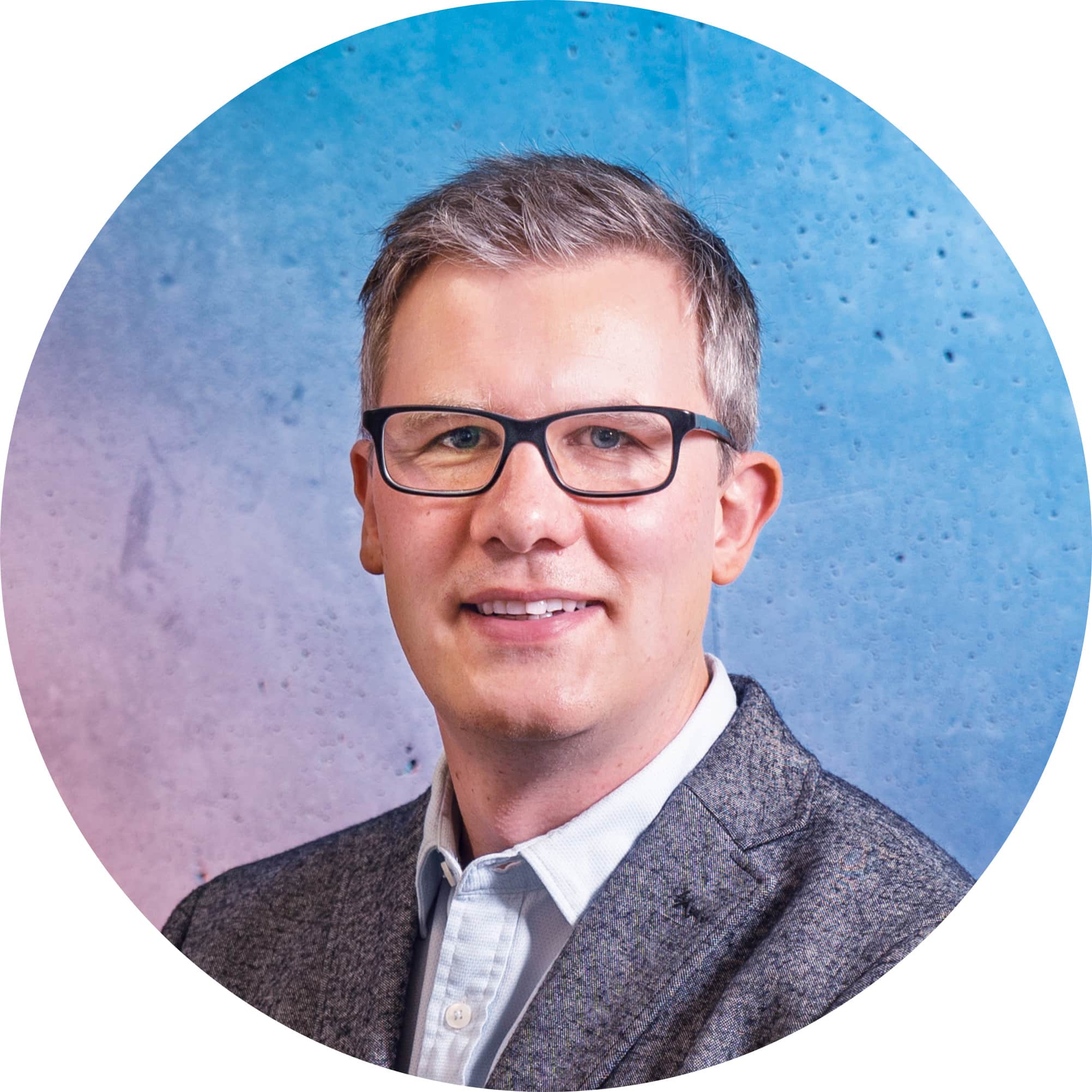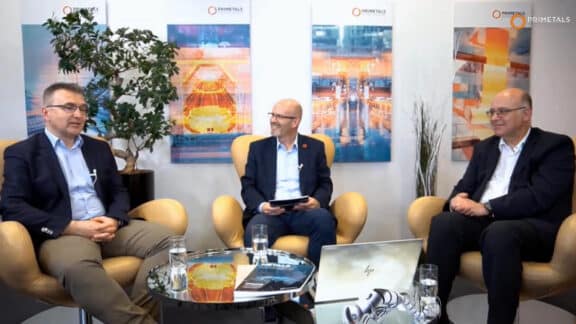What makes a continuous casting machine great? And what does it take to ensure that a “tried-and-tested” technological solution remains at the cutting edge of continuous casting? How can casting as a steel-production step contribute to “greening” the world of metals—and to making metals production even more sustainable? In this session of Pioneers Talk, Tom Widter talks to Paul Pennerstorfer, who leads the global continuous casting business at Primetals Technologies.

Interview with
Paul Pennerstorfer
Hello and welcome to Pioneers Talk my name is Tom Widter and today I have Paul Pennerstorfer here with me in the studio. Welcome, Paul
Pennerstorfer: Tom, pleasure to be with you today.
Paul has been with Primetals Technologies for 20 years. He’s responsible for the continuous casting business for flat and long products and I’m excited because, Paul, you’re the first continuous casting expert to sit in this chair. I was thinking I would start with a somewhat personal question, okay nothing too personal, but a little personal. What fascinates you about the casting of liquid steel?
Pennerstorfer: What is fascinating to me about the continuous casting process, and this was the first thing which was fascinating me from the very first day when I joined our company and the continuous casting business, was that the continuous casting process is the process in the entire production chain of steel where we give the liquid steel the first shape. This is really fascinating to be responsible for the transformation from liquids to solid, where we give the steel the first shape. When we talk about flat production, we make the slabs which then will be rolled to coils for example.
It’s almost a magical process, right? You have something that’s almost like water and then it’s something very solid and hard. My understanding is that Primetals Technologies is unique or almost unique in our industry in terms of leadership in continuous casting. There are technologies that we are renowned for and I’m sure it was very hard to get to that technological level. I’m also sure that it’s hard to stay ahead of the curve. What are you doing to ensure that continuous casters from Primetals Technologies remain the best in the world?
Pennerstorfer: What we are doing in order to keep the pace in the continuous casting is that on the one hand we are very much focusing on the continuous casting process itself and on the other hand, since we are a plant builder, we are focusing on the machinery. We have split the continuous casting machine in modules, which we call technological packages, and depending on the demands of the specific client we’re then choosing the right packages. We are therefore putting them together for the client to make the tailor-made solution they need.
I have a thought experiment for you, Paul. Let’s say you have a greenfield project, meaning there’s nothing there and you can design anything you like for a state-of-the-art caster the world has not seen before. Is there any kind of specification, any kind of benchmark you would want that machine to realize?
Pennerstorfer: I think the question is a little bit too generic because there is not the best caster in the world. It always depends very much on what you’re going to produce out of the caster and what you’re going to produce later on after the cast product is then rolled. But if you want, we can take an example from thick slab casting. Some years ago, when we think about curved type machines, 300 millimeters thickness was somehow the benchmark in thickness which was cast on a continuous casting machine. This means that you could not go thicker. We have done a lot of investigations and process developments together with our clients and so step by step we were able to develop the continuous casting machines in a way that they can produce 400 millimeters thick and above on a curved type continuous casting machine, which gives you apart from excellent quality also a reasonable productivity.
My next question was going to be, what can you do with slabs this thick? So It’s a quality issue, even better quality or can you make different end products from that kind of slab?
Pennerstorfer: So i think it’s somehow kind of both, so the thicker the slab is if you remain with the same plate thickness you can achieve a better quality and on the other hand the thicker the slab the thicker the plate can be, which is then also evaluated in the later process.
Let’s shift gears a little bit. Everyone’s talking about green steel these days and I think it will probably be the most important topic for a couple of years at least and iron and steel making are the areas most affected by this issue. There are emissions, there are energy requirements. Continuous casting has been arguably greener from the get-go, and I still wonder if there are things you can do to support the transition to green steel?
Pennerstorfer: Sure, there are a lot of things we can do. So, actually we are mainly used to cast slabs out of the BOF route. Now the world is changing, and we are seeing that the EAF based steel production route is more and more growing as the EAF route is mainly based on the scrap. The scrap itself brings a lot of residual elements which is posing challenges in the continuous casting project mainly with respect to surface quality. That’s why we have to improve our continuous casting process as well as the technological packages in a way to cope with these new challenges we face with EAF based steel. We should be capable to produce the same quality that we had before in the EAF route too and I think this is one of the main challenges. It is one of the main contributions we can provide in continuous casting for the transition into the carbon neutrality.
That actually sounds like you know secrets that no one else knows. Do you have stuff in the scrap that you can’t get rid of, and you have to adjust the process so that the slab surface is of a satisfying quality? Can you describe how you work with this subpar quality input material?
Pennerstorfer: I think it’s pretty hard to describe in a nutshell. It’s mainly about putting the right type of caster there and putting the right packages together. But moreover, it is about having the operational experience which we gain from a lot of other plants in order to adjust the very little parameters in the continuous casting machine and, for example, for the secondary cooling to produce a high-quality level of steel even out of this EAF-based route.
Paul, I think we’ll conclude with something personal again. You’ve described all the things you’re doing to support the transition to electric steel making, you’ve described technology packages, and your ambition to improve quality in casting even further. What’s next for you? There are so many different topics, is there any one thing that you’re focusing on at this moment?
Pennerstorfer: Basically, we’re focusing on our running projects we have together with our clients. As we all know the supplier market and also the transportation is very difficult and putting everybody under a lot of pressure. This is what we have to deal with to make our projects successful and that the casters to go into operation as soon as possible. On the other hand, as the world does not stand, we are trying to find new clients and convince them with our technology. It’s a pleasure for me to bring some of them to a running reference, meaning a running continuous slab caster, so that they can really see and can touch it and see that it’s running. We will bring them there so they can interact with the operating personnel, they can interact with the quality engineers to talk about the quality which comes out of our casting machines. This is the firsthand information we want our future clients to receive because it’s more impressive and you can get a much better idea than just talking about some slides or brochures.
So, seeing is believing. That is perfect. I think we’ll leave you to that right and thank you very much Paul for sitting down with me today. Thank you all for watching this episode, we will be back with another episode shortly. Have a good time and until then.
Pennerstorfer: Thank you ,Tom.
Pioneers Talk is the new video format of Primetals Technologies, focusing on informative and empowering interviews with experts in metals production and beyond. Topics extend to new advances in digitalization and automation, breakthroughs in green-production solutions, and success strategies for steel producers on all continents.
Paul Pennerstorfer
Paul Pennerstorfer began at Primetals Technologies almost 20 years ago with a master’s degree in chemical engineering and one in law, for good measure. Paul is responsible for the company’s global casting business. He is driven by the desire to stay on the cutting edge, both personally and as an advocate of the casting solutions of Primetals Technologies.
Dr. Tom Widter
Tom Widter joined Primetals Technologies in 2016 and now works in the Marketing and Communications department. He is Editor-in-Chief of Metals Magazine, the company’s customer magazine, and co-host of “Pioneers Talk.” Tom cares deeply about didactics, style, branding, the future of metals, personal growth, and the Oxford comma.

